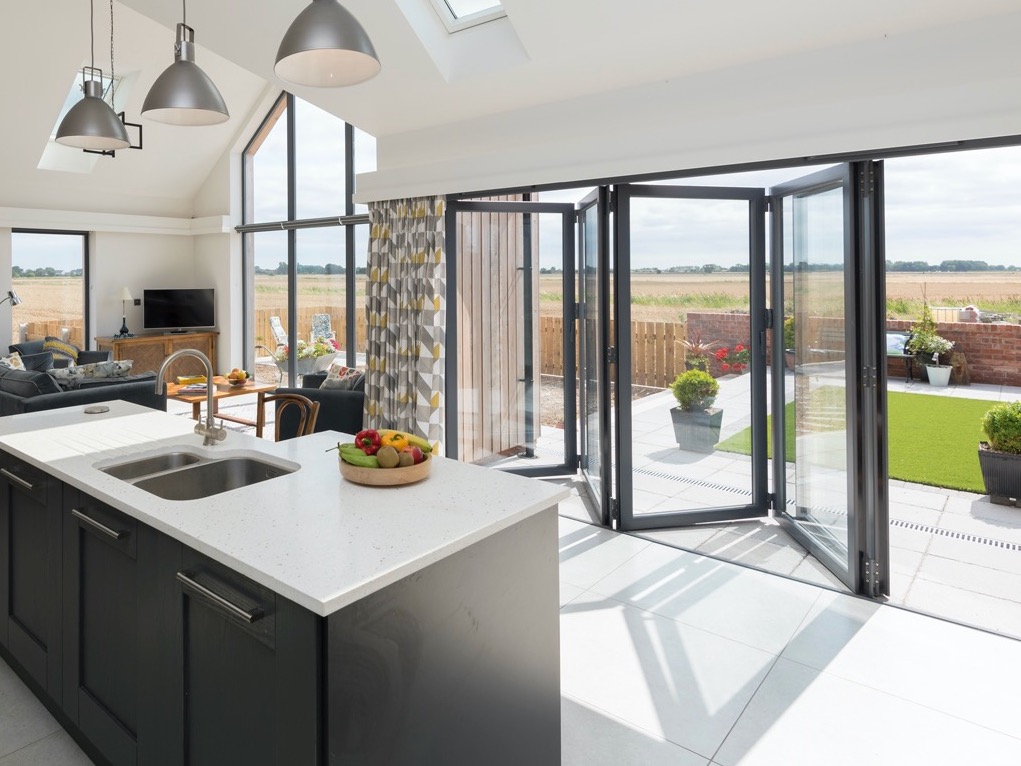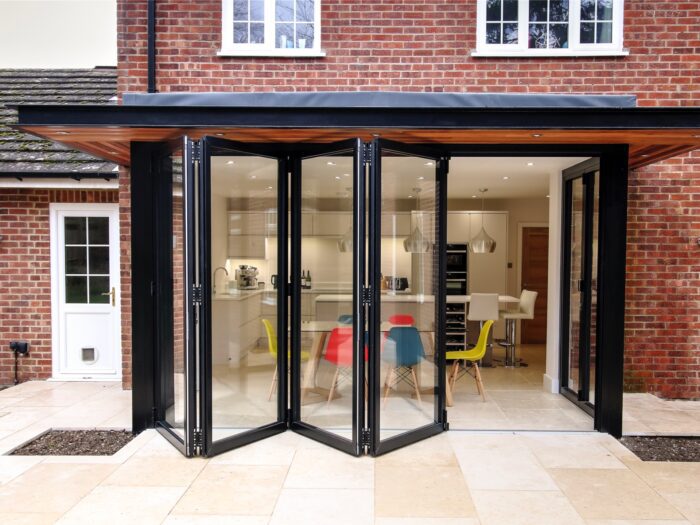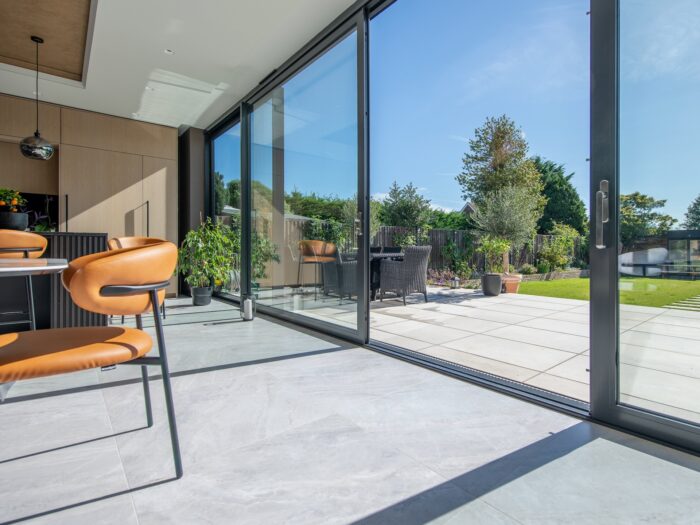
Sliding vs bi-fold doors: Pros and cons of these two glazing options
Surely one of the most popular home improvements of recent times is opening up the back of a building onto the garden with an expansive set of glass doors. It’s usually done by way of a kitchen extension, and it’s an effective way to flood a property with light while creating a sociable indoor-outdoor entertaining space.
And while there are lots of design decisions to be made when undertaking such a project, one of the biggest has to be the choice of glazing. There are plenty of options, French doors and picture windows being two of them. But the most common dilemma must surely be sliding vs bi-fold doors. So which do you choose?
We’ve enlisted the experts to talk about the pros and cons of sliding doors and their bi-fold equivalents. So now – whether you’re renovating your existing space or designing your dream home –you can understand the unique advantages of both and decide which suits your space best.
What are bi-fold doors?
“Bi-fold doors are a type of glazed patio door design with separate panels that concertina to fully open, making them an ideal option for those looking for an uninterrupted, widescreen view of the outdoors,” says Victoria Brocklesby, chief operating officer at Origin.
“The three most common materials used to make residential bi-fold doors are uPVC, wood, and aluminium.”

Ryan Schofield, managing director at the Thames Valley Window Company, adds, “Bi-fold doors differ from sliding doors as they fold back against themselves in a concertina-style, usually to fully open on one side of a property. Typically, they range from two to eight panels and run on a concealed track along the floor. This has a seamless, smooth appearance, makes access to the garden easy, and gives the feeling of the inside and outside being one space. It’s worth noting that you’ll need some outside or inside room for the panels to be stacked to one side, or both, when open.”
What are the benefits of bi-fold doors?
1. They offer more design possibilities
“Both bi-fold and sliding doors can be stylish, secure, and thermally efficient additions to a home,” says Victoria.
“However, bi-fold doors offer more flexibility than sliding doors, as they can be installed in a wider breadth of configurations including floating corner sets, and in a bay format.”
Adds Ryan, “If you’re looking to create seamless indoor-outdoor, contemporary living, then bi-fold doors are the perfect option, as they’ll allow you to open up either part of, or the entire wall of your home. You can also add what’s called a ‘traffic door’ to allow easy access outside without having to open up the whole sliding mechanism.”
2. You can have a completely uninterrupted view
“Bi-folds can also be fully opened for an entirely uninterrupted view as they open, fold and stack out of
the way (either inside or outside of the property depending on preference and space),” says Victoria.
“Sliding doors, on the other hand, stack behind each other, so at least one of the panels will always be visible when the door is open.”
3. They’re a good replacement for French doors
“Bi-fold doors are easier for replacement installations,” says Steve Bromberg, managing director of Express Bi-Folding Doors.
“Sliding doors are generally very deep front to back, which means that a good deal of building prep work is required if you’re replacing French doors with sliding doors. But replacing French doors with new bi-fold doors is relatively easy.”

What are the downsides of bi-fold doors?
1. Your material options might be more limited
While our experts disagree slightly on this point, Steve Bromberg feels that the nature of bi-fold doors mean that certain frame materials are less suitable.
“Bi-folding doors are typically made from aluminium as there are too many moving parts for PVC to cope with,” he says.
“Timber bi-fold doors are available, but they are heavy and need a lot of maintenance.”
That could be limiting if you are on a budget, since PVC tends to be the most affordable option, or if your home is subject to strict planning restrictions – for example, you live in a listed building or conservation area, and your local authority demands you use timber frames.
However, it shouldn’t restrict you aesthetically, since many aluminium frames are available in more than 100 shades, and dual colour options for the interior and exterior of the frame. Origin, for example, offers a choice of 150 RAL colours, and wood-look finishes such as oak.
2. Your view will be more obscured when the doors are closed
“Another disadvantages bi-folds have over sliding doors is that the frames are often thicker due to the hinging required, and the panels can’t go as wide as sliding doors,” says Steve.
“So when the doors are closed, sliding doors arguably look better as they have less frame and more glass.”
3. Bi-folds may require more maintenance
While the maintenance required for bi-fold and sliding doors will largely depend on the material the frames are made from, the construction of a set of bi-fold doors does mean they will need slightly more attention.
“Bi-fold doors are also not a ‘fit and forget’ product, because there’s so many moving parts it’s not uncommon for the door be adjusted over time,” says Steve.
“This should be covered by the guarantee, though it’s worth checking before you invest.”
What are sliding doors?
“Sliding doors tend to be made of two to six large panels of glass, which slide sideways, along a track,” explains Ryan.
“Sliding doors can be designed in a choice of configurations and sliding combinations, or even lift and slide variations for ease of operation with heavier panels.”

“If you have a wider opening to fill and you’re looking for less vertical framing with larger areas of glazing for a less obstructed view of the outside, then sliding doors are the perfect glazing solution for you,” Ryan adds.
“However, when open you will have less clear opening due to the stacking of the moving panels behind the one that’s fixed.”
What are the benefits of sliding doors?
1. They offer the best views when closed
As Ryan explains above, and our other experts mention, too, a sliding panel is going to give you a better view of the garden from within your home in most cases.
“Sliding doors offer the best views of the outside when closed compared to any other type of patio door,” says Victoria.
“This is because they are capable of larger panel sizes than bi-fold, or even French patio doors, which means there are fewer frames to interrupt the view when closed.”
2. There are materials for every look and price point
“Traditional sliding doors can be made from PVC or timber,” says Steve.
“However, the most on-trend large sliding doors are made from aluminium, as the metal is a stronger material.”
This is good news all round, as uPVC comes in a range of colours and can be a good option for those on a budget.
It’s also possible to buy external sliding doors with real-wood frames, which can be advantageous if you live in a listed property.
3. You can open them to varying degrees, and they’re easier to operate
“Sliding doors offer greater control as they can be opened to add just an inch of fresh air if desired, or a couple of feet to pop outside,” says Ryan,
“Although they don’t give you quite the same scale of opening as bi-folds, overall.”
What are the downsides of sliding doors?
1. There are limited ways to configure sliding doors
“Sliding doors are limited by configuration as they can’t be used in a corner configuration without a corner post, or bay,” says Victoria.
“However, they are a great option for a straight wall. They are typically installed in either two, three, four, or six-door sets, but unlike bi-fold doors, they don’t concertina, so at least one of the panels will always be visible when the door is open as they ‘stack’ behind each other.”
2. You’ll never to able to open up your house fully to the outdoors
As we’ve mentioned, you’ll always have at least one glass panel of a sliding door blocking your view, whereas bi-folds can concertina up entirely.
3. Things can go wrong in the installation
This is true of both types of window, in reality, but Steve explains that sliding doors can be more problematic, especially when you opt for super-size glass panes.
“Sliding doors are more common to leak because the tracks are typically deeper,” he explains.
“Also, if the opening isn’t formed correctly and supporting the door, the weight of the glass can cause issues.”
Another reason why it pays to use a highly rated and professional installer.




